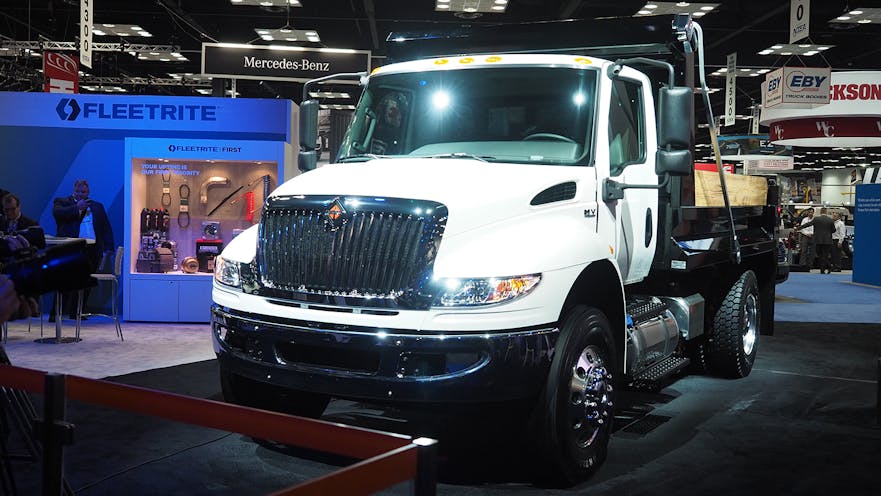With favorable economic conditions and continued growth in construction and other segments, Navistar International is looking to build up its vocational truck business. To that end, the company said it gained 4% market share in medium-duty trucks with its Durastar and is hoping to push that farther with the new MV Series replacing it.
"Our medium-duty trucks deliver food and beverages across the country. Our utility trucks keep the power on. Our tow trucks get us out of jams every day," Michael Cancelliere, president of truck and parts at Navistar International, said at the 2018 Work Truck Show.
"From landscaping to construction and more, our medium-duty trucks keep customers up and running day-in and day-out," he added.
At the unveiling of the new MV Series truck — which is already being produced at Navistar's Springfield, OH plant — Jeff Sass, the company's senior vice president of North American sales and marketing, walked the audience through a virtual tour of the MV using a virtual reality headset and hand controls.
Some highlights of the MV Series he pointed out include:
• Compared with the Durastar, the MV offers more visibility. On average, the MV has a 4% improvement in visibility to the front and sides.
• Similar to Navistar's HV, LT and RH, the MV's door omits a wing window and features a pedestal mirror. The door had to be stiffened to support that mirror, Sass explained, "and by stiffening it, we made the seal on the cab tighter, which cut down on wind noise and blowback."
• The pedestal mirrors were moved down and forward to increase visibility, which also increased side visibility. To look in the mirrors, the driver has to turn his or her head 5 degrees less to the left and 15 degrees less to the right less than standard mirrors. "That doesn't sound like much, but if you're driving for 10 hours and you're turning your head to check the mirrors, it's quite a bit when it comes to fatigue."
• The MV's flat panel dash allows for a bench seat up front to accommodate a three-person crew.
• The wheels have a 50-degree cut in both directions, allowing the MV a turning radius of as little as 40 feet, depending on wheelbase.
• The MV's frame comes with custom piercing for body manufacturers to use to install various bodies. "This gives them the opportunity to install quicker and more consistently from the factory," Sass noted.
• A passenger-car-like toggle switch for the center readout in the instrument cluster lets the driver scroll through different screens and info such as fuel economy and tire pressure.
• International's proprietary shifter has simple controls: forward, reverse, neutral and Jake brake.
• The MV's HVAC system will completely defrost "a sheet of ice" on the windshield, starting with the cab at 0 degrees Fahrenheit, in 25 minutes. "25 minutes sounds like a long time," Sass said, "but I'll tell you, we had our competitors in there, and the new MV HVAC system was the fastest of any of them. One even took 72 minutes in order to have the same thing we did in 25."
• Switches on the truck's B-panel were designed with help from drivers, who asked for them to be wider. "They can operate them [the switches] with gloves, as you do many times in work environments," Sass pointed out. The MV's switches also feature clicks you can hear and feel, according to Navistar.
• Buttons on the steering wheel have laser-etched graphics for increased durability.
• The MV also has a pre-trip inspection button. "A single operator can push the pre-trip start, hop out of the truck and the lights will go on, from headlights to fog lights to marker lights and the lights in the back. They're able to go all the way around and check it with just one push," said Sass.
• The truck has a fully programmable power take-off (PTO) switch "with a full suite of PTOs, whether it's front engine, rear engine or flywheel. The interlocks on this also protect the operator, the equipment and the truck itself," Sass noted.
Navistar has expanded its Uptime Command Center vehicle monitoring to vocational vehicles to help predict when repairs are needed, according to Cancelliere. The goal is to get 80% of vehicle repairs at its dealer network turned around in 24 hours and 100% within 48 hours. He noted that the company has expanded its coverage of the International A26 12.4L engine for vocational trucks.
"If a truck has a warrantable failure on an International A26 engine and experiences downtime greater than 48 hours from the time of diagnosis, International Truck will provide the customer with a $250 International Advantage card good for future parts and service at any dealer in the country," Cancelliere said.
Navistar has also launched a four-year, 100,000-mi. warranty for vocational vehicles that covers complete powertrain and drivetrain coverage, he noted, and added an International four-year concrete barrel protection plan.
"Here's how it works," said Cancelliere. "If a customer experiences an International A26 warrantable failure resulting in barrel damage, International will cover the barrel damage for the truck's first four years in service.
"This coverage is provided for our customers at no additional cost," he continued. "That's putting our money where our mouth is, and it also demonstrates our confidence in the product and our vehicles, and specifically in the International A26 engine."



